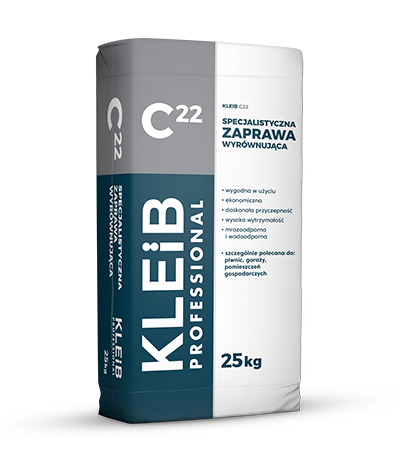PROFESSIONAL LEVELLING MORTAR
KLEIB C22 is a mortar for levelling horizontal and vertical surfaces inside and outside of buildings, for making slopes in bathrooms, basements, on balconies, for filling holes, cavities and making subfloors on all types of mineral substrates designed for final finishing cladding such as: tiles of various types of materials, PVC flooring, carpeting, panels, boards etc. in layers from 3 to 50 mm. It can be used for making cement floors (screeds) in less trafficked areas, such as basements, garages, utility rooms. Due to its properties it is suitable for use as a floating floor layer on the damp or thermal insulation with the minimum thickness of 50 mm. It can also be used for local levelling and patching of surfaces, filling gaps and cavities in the floor surface with 10-80 mm thick layers.
- easy to use
- economical in use
- excellent adhesion
- high durability
- frost resistant and waterproof
- particularly recommended for: basements, garages, utility rooms

25 kg
54
KLEIB C22 is a mortar for levelling horizontal and vertical surfaces inside and outside of buildings, for making slopes in bathrooms, basements, on balconies, for filling holes, cavities and making subfloors on all types of mineral substrates designed for final finishing cladding such as: tiles of various types of materials, PVC flooring, carpeting, panels, boards etc. in layers from 3 to 50 mm. It can be used for making cement floors (screeds) in less trafficked areas, such as basements, garages, utility rooms. Due to its properties it is suitable for use as a floating floor layer on the damp or thermal insulation with the minimum thickness of 50 mm. It can also be used for local levelling and patching of surfaces, filling gaps and cavities in the floor surface with 10-80 mm thick layers.
The substrate should be stable, structurally sound and clean, i.e. free from impurities that could impair the adhesion of the mortar. Excessively absorbent surfaces should be primed with KLEIB G1 primer before performing any work.
The mortar is prepared by pouring the entire contents of the bag into a container with a measured amount of water and mixing until a smooth, lump-free uniform consistency is obtained. This is best done using a concrete mixer or an electric drill with a mixer attachment in case of minor works. The mortar is ready to use after 5 minutes and after remixing. Prepared mortar is to be used within approx. 4 hours.
When making subfloors or screeds, apply KLEIB C22 in stripes between the previously levelled guides and level using a straight edge. This work can best be carried out without interruptions. The ready subfloor or screed should be protected from drying out too quickly. Large surfaces need to be separated by anti-shrinkage expansion joints, in accordance with subfloor or screed technology and design. Expansion joints should also be used to separate the area from other structural elements of the building such as columns, walls and stairs, and where its thickness changes. General rules for plaster work must be observed when using the mortar to level vertical surfaces. Any holes or cavities in the substrate must be filled up with layers up to 80 mm thick beforehand and left to harden for the period of 2-3 days. Use at temperatures between +5°C and +30° C. Tools should be washed with clean water immediately after use.
Approximately 2 kg of mass are used per 1m², with the thickness of 1.0 mm.
The mortar must be transported and stored in tightly sealed bags, in dry conditions (preferably on pallets). Protect from dampness. Shelf life in conditions that comply with the specified requirements is up to 12 months from the production date on the packaging.
